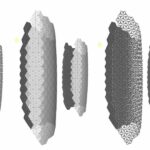- Usually, when something gets warmed up, heat tends to spread outward before eventually dissipating. But things are a little different in the world of superfluid quantum gas.
- For the first time, MIT scientists have successfully imaged how heat actually travels in a wave, known as a “second sound,” through this exotic fluid.
- Understanding this dynamic could help answer questions about high-temperature superconductors and neutron stars.
Earth’s greenhouse
In the world of average, everyday materials, heat tends to spread out from a localized source. Drop a burning coal into a pot of water, and that liquid will slowly rise in temperature before its heat eventually dissipates. But the world is full of rare, exotic materials that don’t exactly play by these thermal rules.
Instead of spreading out as one would expect, these superfluid quantum gasses “slosh” heat side to side—it essentially propagates as a wave. Scientists call this behavior a material’s “second sound” (the first being ordinary sound via a density wave). Although this phenomenon has been observed before, it’s never been imaged. But recently, scientists at the Massachusetts Institute of Technology (MIT) were finally able to capture this movement of pure heat by developing a new method of thermography (a.k.a. heat-mapping).
The latest results of this study were published in the journal Science, and in an university press release highlighting the achievement, MIT assistant professor and co-author Richard Fletcher continued the boiling pot analogy to describe the inherent strangeness of “second sound” in these exotic superfluid.
“It’s as if you had a tank of water and made one half nearly boiling,” Fletcher said. “If you then watched, the water itself might look totally calm, but suddenly the other side is hot, and then the other side is hot, and the heat goes back and forth, while the water looks totally still.”
These superfluids are created when a cloud of atoms is subjected to ultra-cold temperatures approaching absolute zero (−459.67 °F). In this rare state, atoms behave differently, as they create an essentially friction-free fluid. It’s in this frictionless state that heat has been theorized to propagate like a wave.
“Second sound is the hallmark of superfluidity, but in ultracold gases so far you could only see it in this faint reflection of the density ripples that go along with it,” lead author Martin Zwierlein said in a press statement. “The character of the heat wave could not be proven before.”
To finally capture this second sound in action, Zweierlein and his team had to think outside the usual thermal box, as there’s a big problem trying to track heat of an ultracold object—it doesn’t emit the usual infrared radiation. So, MIT scientists designed a way to leverage radio frequencies to track certain subatomic particles known as “lithium-6 fermions,” which can be captured via different frequencies in relation to their temperature (i.e. warmer temperatures mean higher frequencies, and vice versa). This novel technique allowed the researchers to essentially zero in on the “hotter” frequencies (which were still very much cold) and track the resulting second wave over time.
This might feel like a big “so what?” After all, when’s the last time you had a close encounter with a superfluid quantum gas? But ask a materials scientist or astronomer, and you’ll get an entirely different answer.
“It is very difficult to change the properties of a medium quick enough, uniformly, and with enough contrast to time reflect electromagnetic signals because they oscillate very fast,” Gengyu Xu, a coauthor and post-doc student at CUNY ASRC, said in a press statement. “Our idea was to avoid changing the properties of the host material, and instead create a metamaterial in which additional elements can be abruptly added or subtracted through fast switches.”
Superfluidity of liquid helium
This time reflection also behaves differently than spatial reflections. Because this time echo reflects that last part of the signal first, the researchers say that if you looked in a time mirror, you would see your back instead of your face. To translate the experience acoustically, it’d be like listening to a tape on rewind—which is to say fast and high-pitched.
The shift in frequency, if it could be perceived by our eyes, would look like colors of light suddenly changing to another color, such as red switching to green. This strange counter-intuitive nature of time reflection is part of what has made studying the concept so difficult.
While exotic superfluids may not fill up our lives (yet), understanding the properties of second wave movement could help questions regarding high-temperature superconductors (again, still at very low temperatures) or the messy physics that lie at the heart of neutron stars.
“This has been really exciting to see, because of how long ago this counterintuitive phenomenon was predicted, and how different time-reflected waves behave compared to space-reflected ones,” corresponding author Andrea Alù, a physics professor and director of CUNY ASRC’s Photonics Initiative, said in a statement.
The big question: Why have scientists worked toward recreating this theoretical time reflection in a laboratory? Well, more minute control of electromagnetic waves can vastly improve wireless communications and even lead to advancements in low-energy, wave-based computers.
In other words, it simply helps to know everything there is about electromagnetic waves—both forward and backward.












